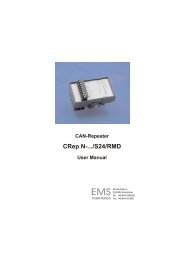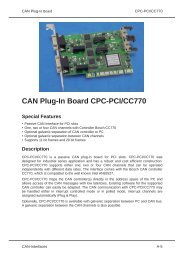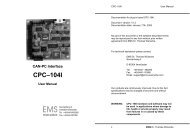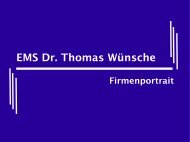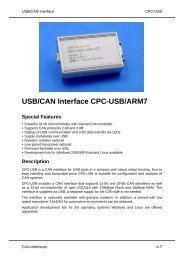CAN Repeater CRep S8C Special Features - Ems-wuensche.com
CAN Repeater CRep S8C Special Features - Ems-wuensche.com
CAN Repeater CRep S8C Special Features - Ems-wuensche.com
Create successful ePaper yourself
Turn your PDF publications into a flip-book with our unique Google optimized e-Paper software.
<strong>CAN</strong><strong>Repeater</strong><br />
<strong>CRep</strong> <strong>S8C</strong><br />
<strong>CAN</strong><strong>Repeater</strong> <strong>CRep</strong> <strong>S8C</strong><br />
<strong>Special</strong> <strong>Features</strong><br />
• Protocol transparent <strong>CAN</strong> repeater<br />
• 8 <strong>CAN</strong> channels<br />
• Low propagation delay<br />
• Links for cascading up to 3 devices with one supply<br />
• ISO 11898 <strong>com</strong>patible bus interface<br />
• Detach of dominant locked bus segments<br />
• Rail mountable<br />
Description<br />
The <strong>com</strong>pact <strong>CAN</strong> repeater <strong>CRep</strong> <strong>S8C</strong> transmits and amplifies signals transparent to the<br />
<strong>CAN</strong> protocol. Each of the eight <strong>CAN</strong> connections has the physical behaviour of a single bus<br />
node. <strong>CRep</strong> <strong>S8C</strong> permits a flexible design of the network topology and offers special support<br />
for star structured networks. Furthermore tree structures and long stub lines are supported.<br />
Through the possibility to use the network structure that fits the application best a reduction of<br />
installation costs can be reached.<br />
The maximum data rate in <strong>CAN</strong> networks, depending on signal propagation delays, can be<br />
increased, if <strong>CRep</strong> <strong>S8C</strong> is used to improve the network structure. An increase of the<br />
maximum node count in a <strong>CAN</strong> network can be reached by splitting the network in subnets<br />
that are connected by <strong>CRep</strong> <strong>S8C</strong>. Each subnet makes the number of <strong>CAN</strong> nodes possible<br />
permitted by the drivers output current. Where <strong>CAN</strong> signals have to be transmitted over long<br />
distances, <strong>CRep</strong> <strong>S8C</strong> can be used for signal conditioning. The capability to detach erroneous<br />
segments from the rest of the <strong>CAN</strong> system reduces the impact on the intact bus segments for<br />
the most <strong>com</strong>monly occuring errors.<br />
The presence of power is indicated by a LED. Furthermore each <strong>CAN</strong> channel is provided<br />
with a LED indicating that this channel has originated a <strong>CAN</strong> message when the LED is on.<br />
Network Technology<br />
C5
<strong>CRep</strong> <strong>S8C</strong><br />
<strong>CAN</strong>‐<strong>Repeater</strong><br />
Technical Data<br />
Layout and Connection<br />
A <strong>CRep</strong> <strong>S8C</strong> device includes 8 <strong>CAN</strong> segments, wired by terminal blocks with 3 clamps. The<br />
power supply of <strong>CRep</strong> <strong>S8C</strong> is separately wired by a terminal block with 2 clamps.<br />
Pin Name Function<br />
1 <strong>CAN</strong>_H <strong>CAN</strong> high bus line<br />
2 <strong>CAN</strong>_L <strong>CAN</strong> low bus line<br />
3 GND Ground<br />
The following table shows the terminal assignment of the power connector:<br />
Pin Name Function<br />
1 Power + Positive supply +24V<br />
2 Power ‐ Ground<br />
The power supply is galvanicly decoupled from the <strong>CAN</strong> system.<br />
Limiting Values<br />
Parameter Minimum Maximum Unit<br />
Storage temperature 40 +80 °C<br />
Operating temperature 20 +60 °C<br />
Power supply voltage 100 +35 V<br />
Voltage on signal lines 30 +30 V<br />
Maximum power dissipation (at 60°C)<br />
‐<br />
tbd mW<br />
Any (also temporary) stress in excess of the limiting values may cause permanent damage on <strong>CRep</strong> <strong>S8C</strong> and<br />
other connected devices. Exposure to limiting conditions for extended periods may affect the reliability and<br />
shorten the life cycle of the device.<br />
Nominal Values<br />
Parameter Minimal Typical Maximal Unit<br />
Current consumption (running idle)<br />
‐ 70 ‐ mA<br />
Current consumption (250 kBits/s, 100% busload)<br />
‐<br />
tbd<br />
‐ mA<br />
Supply voltage 19 24 30 V<br />
Propagation delay between two arbitrary channels<br />
‐ 130 200 ns<br />
Propagation delay cascade<br />
‐ 8 10 ns<br />
All values, unless otherwise specified, refer to a supply voltage of 24V and an environmental temperature of 20°C.<br />
C6<br />
Network Technology




